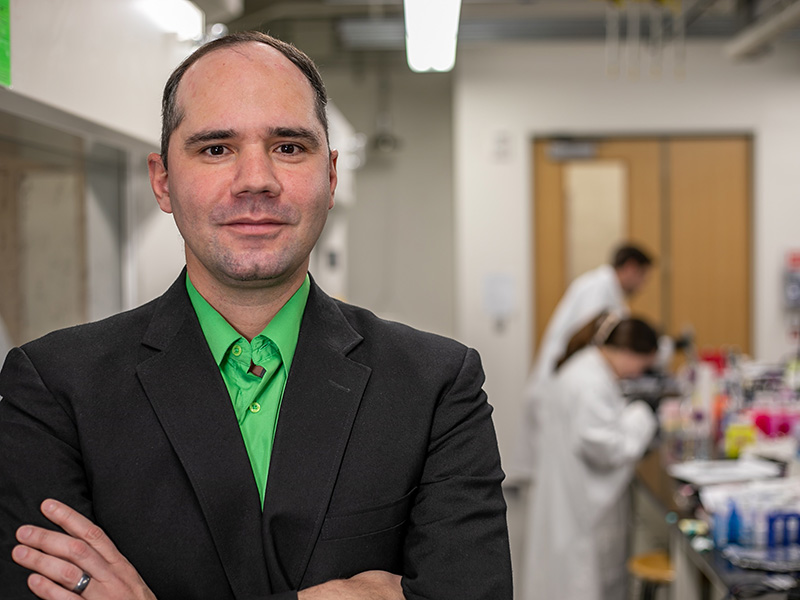UVA Study Could Offer a Solution to the Growing Threat of Antibiotic Resistance

Almost a decade has passed since the World Health Organization declared that antibiotics are losing their effectiveness. The problem is leading to longer hospital stays, higher medical costs and increased mortality rates caused by infections that were once fairly routine to treat, but both medical science and the pharmaceutical industry have made little progress in finding a solution. However, researchers at UVA recently received a $3 million grant from the National Institutes of Health to develop a promising new approach to understanding how antibiotics enter bacterial cells which could lead to new possibilities for treating infections that are increasingly becoming life-threatening.
While working with dyes that would allow researchers to observe the interactions of bacterial cells and animal cells in live tissue to better understand the role of the gut microbiome in human health and survival, research chemist Marcos Pires, an associate professor of chemistry in UVA’s College and Graduate School of Arts & Sciences, realized that a similar procedure could be used to understand how antibiotics are able to permeate the bacterial cells known as Gram-negative bacteria, a category of infection-causing bacteria that are particularly resistant to treatment because they have two cell walls instead of one.
Gram-positive bacteria, which can cause diseases like pneumonia, food poisoning and strep throat have single-layer cell walls and are easily treated by existing antibiotics, but Gram-negative bacteria like E. coli, Salmonella and Legionella are more resistant to the drugs developed to treat them. If nothing is done to address the ability of these organisms to resist the drugs that target them, Pires suggested, even a routine hospital visit or an elective surgical procedure could turn deadly.
Pires noted that we’ve already seen several high-profile cases of professional athletes like players like Peyton Manning and Tom Brady dealing with complications from post-surgical infections, and the problem is likely to be even more dangerous for patients who don’t have the resources available to MVPs in the NFL.

One of the problems medical science is facing in developing solutions to the problem of antibiotic resistance is that the process of measuring how many molecules of a drug are able to enter a target cell is still a challenge.
“When we first applied for the grant in 2022, we thought this had to be old news…it has to be a solved problem,” Pires said. “Come to find out, it wasn’t.”
According to Pires, the process is time consuming and requires highly specialized equipment, which limits the number of studies being carried out, and that makes the cost of developing new drugs extremely costly. As a result, Pires said, pharmaceutical companies aren’t investing in solving the problem.
A landmark study in 2019 that likely required extensive efforts to complete was able to identify as many as 200 unique molecules that were able to enter target cells of Gram-negative bacteria. Using the process Pires developed, however, his team has been able to identify as many as 3,000 individual molecules every week.
“We thought there must be a simple way to do this, and there was. And it’s pretty robust and pretty easy to do, and that’s how we were able to get the attention of the NIH,” Pires said.
In collaboration with UVA chemistry professor Andreas Gahlmann, Pires and his team have also been able to identify characteristics of certain types of bacteria that either allow molecules into a cell or turn them away, preventing antibiotics from reaching an effective concentration . The system they are developing will help research exploit those characteristics more effectively to design new drugs that defeat the mechanisms of drug resistance.
“We can use our system to essentially describe the kind of molecules that can hop in through these pores or importers, and we can describe molecules that are likely to be ejected and are likely to be resisted very quickly,” Pires said.
The work has earned Pires a grant from the NIH that will fund this research team at UVA for the next five years and will result in a more comprehensive understanding of how drug molecules are able to permeate bacterial cell walls, making the process of developing new drugs much faster. Pires is also teaming up with a computational research team at Lehigh University in Pennsylvania that will develop a machine-learning algorithm that could help predict how much of a particular drug will enter a target cell. The tools will allow pharmaceutical researchers to identify new drug prospects more quickly and eliminate those that aren’t likely to work with less cost and effort, and they may help in developing drugs that are better able to target sources of infection than existing antibiotics.
“If we can do that, we’d be in a position that the field doesn’t have right now -- that people looking to design antibiotics don’t have the tools to do,” Pires said.
“Pires’ work addresses the biggest problem with antibiotic resistance in bacteria: that bacteria have evolved to prevent antibiotics from entering. His research promises to give an unprecedented look into how bacteria prevent antibiotics from getting across the double barriers of the outer and inner bacterial membranes,” said William Petri, a professor of medicine with UVA’s School of Medicine and chief of the Division of Infectious Diseases and International Health at the University. “Every time I am on the infectious diseases service in the hospital, I am encountering life-threating bacterial infections, and we have few antibiotics left that we can use to treat them. Pires brings a fresh perspective, ideas and approaches to one of our most pressing problems.”









